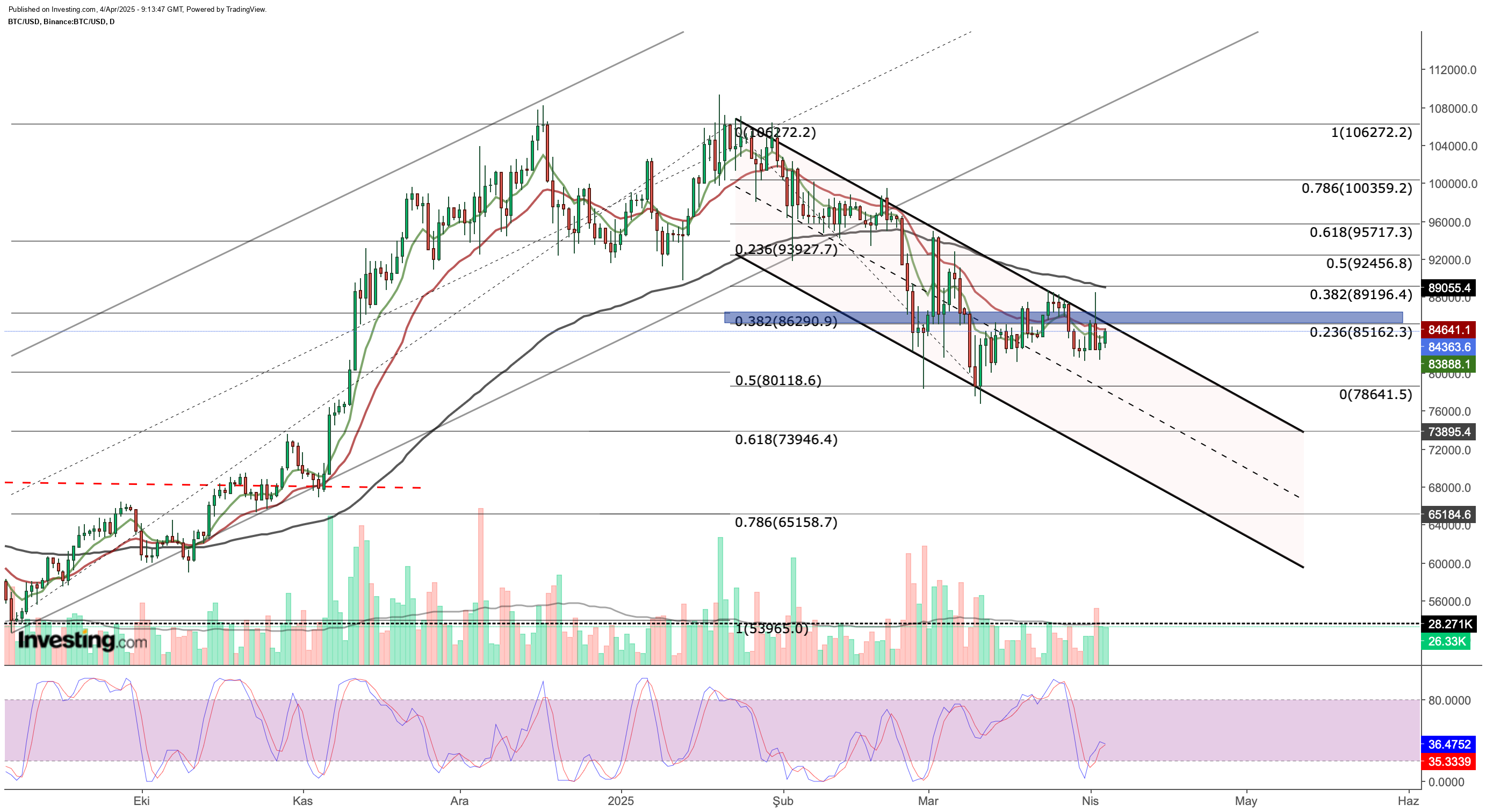- Trump’s tariffs have led to global market fluctuations, which have also affected Bitcoin’s price.
- Bitcoin’s price is now more correlated with traditional market movements due to economic policy influences.
- Bitcoin, however, needs to break above $86,300 to signal a potential upward trend; otherwise, it may continue to fall.
- Looking for more actionable trade ideas to navigate the current market volatility? Subscribe here to unlock access to ProPicks AI winners.
Global markets faced sharp fluctuations after Trump’s tariff announcement this week. The tariffs hit US stock markets hard, with steep declines in the , , and . This also affected the cryptocurrency market.
initially rose after Trump’s announcement but then dropped about 5% to $81,300. However, selling pressure has been absorbed for now. At first, BTC climbed as high as $88,500 but later followed a downtrend, holding its one-week support level near $82,500. As stock markets see their steepest declines since the COVID-19 pandemic, Bitcoin’s resilience has given investors some confidence.
However, concerns about the global economy remain a major risk for crypto. Tariffs could increase inflation, which may lead to take a stricter stance on cuts. This would create a less favorable environment for . Given the rapid flow of capital in the crypto market, macroeconomic risks could lead to even more volatility in the coming week.
Macroeconomic Risks Threaten Bitcoin
US trade policies and Trump’s tariffs are having a negative impact not only on the US economy but also on global markets. In particular, the pressure that new tariffs could put on crypto assets could trigger Bitcoin’s short-term selloff. However, Bitcoin’s future does not only depend on trade policies. Global liquidity conditions, the Fed’s interest rate decisions and monetary steps such as quantitative easing (QE) will be more crucial factors determining Bitcoin’s price movements.
Given the current situation, Trump’s statements and trade policies have added pressure to traditional markets, contributing to Bitcoin’s gradual decline. Reaction buying has remained limited as selling pressure has built up since February.
While the crypto market’s internal dynamics are strong, the dominance of ETF-driven trading has made traditional market influences more pronounced. This has kept Bitcoin from acting as a safe haven and increased its correlation with riskier assets like stocks.
Bitcoin’s Technical Outlook

Bitcoin continues its downward trend as uncertainty in global markets makes it difficult for investors to take positions. After breaking below its ascending channel in February, Bitcoin’s decline accelerated, and it is now moving within a falling channel.
Last month, Bitcoin dropped to the $76,000 range, finding support at the lower boundary of this channel. It rebounded to the $86,000 (Fib 0.382) region last week but is currently struggling to break through the upper band of the channel.
From a technical perspective, a daily close above $86,300 would be the first sign of a potential trend reversal for Bitcoin. If this level is surpassed, Bitcoin’s price will move above short-term exponential moving averages, which are also showing bullish signals.
Additionally, the Stochastic RSI on the daily chart has turned upward, indicating further upside potential. In a possible rebound, the 3-month EMA at $89,200 could act as a key resistance level. Breaking through this barrier could quickly push Bitcoin into the $95,000–$100,000 range.
If Bitcoin fails to sustain buying above $86,300, the bullish setup could weaken. In that case, Bitcoin is likely to remain within the falling channel, with a potential drop below $80,000 toward the $74,000 level (Fib 0.618). Losing this support could open the door for a deeper decline to $65,000 (Fib 0.786), aligning with the lower boundary of the falling channel based on the current swing.
Consistently closing above $86,300 on the daily chart would be a key indicator for sustaining the short-term uptrend. A breakout above this level could push Bitcoin toward the critical resistance at $89,200, potentially setting the stage for a rally to the $95,000–$100,000 range. However, if Bitcoin struggles to hold above $86,300, selling pressure could increase, leading to a drop below $80,000 and possibly extending losses toward $74,000. A failure to hold $74,000 could trigger a deeper retracement to $65,000.
***
Be sure to check out InvestingPro to stay in sync with the market trend and what it means for your trading. Whether you’re a novice investor or a seasoned trader, leveraging InvestingPro can unlock a world of investment opportunities while minimizing risks amid the challenging market backdrop.
Subscribe now and instantly unlock access to several market-beating features, including:
- ProPicks AI: AI-selected stock winners with proven track record.
- InvestingPro Fair Value: Instantly find out if a stock is underpriced or overvalued.
- Advanced Stock Screener: Search for the best stocks based on hundreds of selected filters, and criteria.
- Top Ideas: See what stocks billionaire investors such as Warren Buffett, Michael Burry, and George Soros are buying.

Disclaimer: This article is written for informational purposes only. It is not intended to encourage the purchase of assets in any way, nor does it constitute a solicitation, offer, recommendation or suggestion to invest. I would like to remind you that all assets are evaluated from multiple perspectives and are highly risky, so any investment decision and the associated risk belongs to the investor. We also do not provide any investment advisory services.


